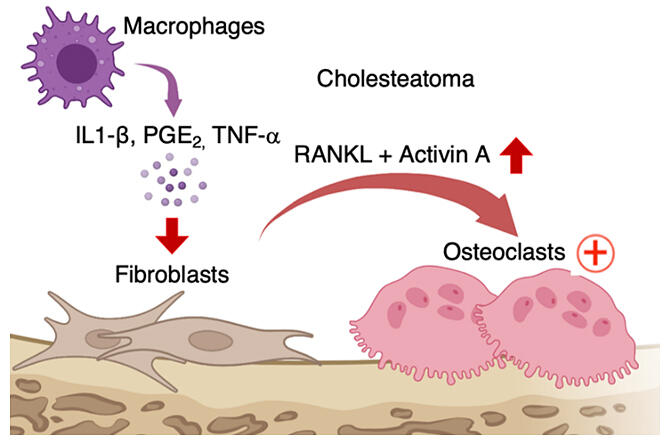A research group led by Specially Appointed Researcher Kotaro Shimizu, Associate Professor Junichi Kikuta, Professor Masaru Ishii, and Professor Hidenori Inohara of the Graduate School of Medicine at Osaka University has announced the first-ever identification of new pathogenic fibroblasts that induce bone destruction via cytokine activin A in middle ear cholesteatoma, an orphan disease that causes destruction of the ear bones. (Cytokines are secreted proteins that regulate various biological activities, including nerve cell growth and differentiation.) This was discovered through single-cell RNA sequencing analysis. Surgery has been the only conventional treatment for this disease, but a conservative treatment is expected to be developed through drug discovery. The findings were published in the international journal Nature Communications.

Provided by Osaka University
Middle ear cholesteatoma, which is a type of noncancerous skin cyst that can develop in the middle ear, can become chronically inflamed, leading to bone destruction. A portion of the eardrum invades the middle ear, and as the cholesteatoma grows, the inner ear (which senses hearing and balance) is destroyed. Current treatment involves surgical removal of the cholesteatoma and repair of the destroyed areas. However, the cause of the bone destruction was not well understood.
The research group performed a process called 'single-cell RNA sequencing analysis,' in which the RNA sequence of each cell was read for each cholesteatoma removed from the patient during surgery. In this analytical method, complementary DNA (cDNA) is first generated from the messenger RNA contained in a single cell. Then, after its amplification, the RNA sequence is read using a next-generation sequencer, allowing quantitative analysis of the expression levels of all genes on a cell-by-cell basis.
As a result, the research group found that cholesteatoma fibroblasts produce the cytokine activin A, a protein, and some of those fibroblasts produce excessive amounts of this protein. The study showed that bone destruction is induced by activin A, which promotes the differentiation of bone-destroying osteoclasts. Experiments in a mouse model of middle ear cholesteatoma also confirmed that suppressing activin A production in fibroblasts reduces the number of bone-destroying osteoclasts. They also found that the inhibition of activin A may be a targeted strategy for the treatment of middle ear cholesteatoma, and that this is expected to open up new conservative drug treatment options for this disease for which surgery has been the only treatment option.
This new discovery that bone destruction is induced by specialized fibroblasts is expected to contribute to the clarification of bone-destroying diseases other than middle ear cholesteatoma, such as rheumatoid arthritis and the development of novel therapies for such diseases.
Ishii stated, "In cholesteatoma, inflammation in the ear causes local fibroblasts to produce a molecule called activin A, which attracts osteoclasts to the area. Middle ear cholesteatoma is a disease that tends to recur, and the only way to treat it nowadays is to surgically remove the cysts. However, in the future, it may be controlled with therapeutic drugs."
Journal Information
Publication: Nature Communications
Title: Single-cell transcriptomics of human cholesteatoma identifies an activin A-producing osteoclastogenic fibroblast subset inducing bone destruction
DOI: 10.1038/s41467-023-40094-3
This article has been translated by JST with permission from The Science News Ltd. (https://sci-news.co.jp/). Unauthorized reproduction of the article and photographs is prohibited.




